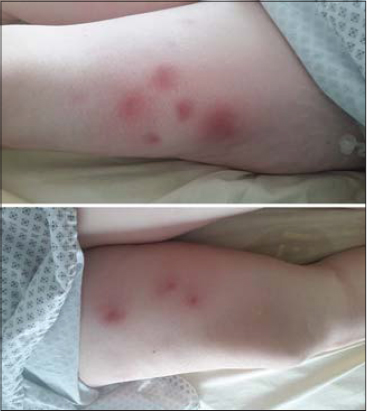Pancreatic panniculitis of the thighs revealing pancreatitis severe acute pancreatitis
Siham Belmourida , Brigitte Dréno
, Brigitte Dréno
Department of Dermatology-Venereology, Nantes University Hospital, Nantes, France
Corresponding author: Siham Belmourida, MD
Submission: 06.11.2020; Acceptance: 14.02.2021
DOI: 10.7241/ ourd.2021e.26
Cite this article: Belmourida S, Dréno B. Pancreatic panniculitis of the thighs revealing pancreatitis severe acute pancreatitis. Our Dermatol Online. 2021;12(e):e26.
Citation tools:
Copyright information
© Our Dermatology Online 2021. No commercial re-use. See rights and permissions. Published by Our Dermatology Online.
Sir,
Pancreatic panniculitis is a rare disease involving fat necrosis in the panniculus in association with pancreatic disease. The rarity of this condition is best described by Mullin et al. who reported one case of panniculitis out of 893 patients with various pancreatic diseases [1,2].
We report a new case of cytosteatonecrosis associated with severe acute pancreatitis.
A 50-year-old woman presented to the emergency room with severe abdominal pain. A highlight of his medical history was alcohol addiction. Her general condition was maintained and she did not have a fever. On examination, she presented several painful and inflammatory knots on the anterior surface of both thighs, 1 to 3 cm in diameter (Figs. 1a and 1b). Laboratory examinations revealed lipasemia at 5,000 U / L (normal 73–393), associated with marked inflammatory syndrome, while abdominal computed tomography established severe acute pancreatitis requiring a stay in intensive care with a patient. radiological drainage of the necrosis castings followed by a total colectomy, gunmetal ileostomy and terminal ileostomy. Cutaneous histopathology of the thigh knots was pathognomonic of pancreatic panniculitis: lobular panniculitis with extensive steatonecrosis and saponified lipid acids.
The course was marked by the spontaneous resolution of these knots and the normalization of lipasemia levels after taking her pancreatitis.
Pancreatic panniculitis affects 2% to 3% of patients with pancreatic disease [1,2]. This involves fat necrosis in the panniculus and distant foci in pancreatic diseases such as acute or chronic pancreatitis and pancreatic carcinoma. It is less commonly associated with pancreatic pseudocyst, post-traumatic pancreatitis, pancreatic divisum or haemophogocytic syndrome [2]. The pathogenesis is unknown but has been postulated to involve the release of pancreatic enzymes, particularly amylase and lipase from the diseased pancreas, causing subcutaneous fat necrosis. [3]. Skin histopathology findings of panniculitis are virtually pathognomonic, described as ghost-like anucleated cells with shadowy walls. Panniculitis manifests as tender erythematous nodules on the lower extremities but can also occur on the arms, trunk or back. These lesions may ulcerate and extrude an oily discharge. Skin lesions are the presenting feature in about 40% of pancreatic panniculitis and in some cases precede development of pancreatic disease. There may be joint manifestations of arthritis or arthralgia. Not much is known of the underlying pathogenesis in pancreatic panniculitis. Some studies postulate that increased levels of lipolytic enzymes of pancreatic origin, once they freely circulate in the tissues, are cytotoxic for many cells including leukocytes and therefore perpetuate inflammation [3,4].
This case is a vivid example of how lesions on the skin can be the first signs of serious undiagnosed disease. Panniculitis can be attributed to many causes, including infection, medication, trauma, or connective tissue disease. Panniculitis is most commonly idiopathic, or caused by streptococcal and other infections, such as upper respiratory tract viruses and Mycobacterium tuberculosis. Pancreatic panniculitis is rare, scientific literature describes less than 150 cases.
Pancreatic panniculitis is a rare condition that can be difficult to diagnose, especially as the pancreatic manifestations are often secondary. It is clinically evoked and confirmed by histology which identifies fatty necrosis. The treatment is first of all the treatment of pancreatic pathology which is sometimes difficult in the case of pancreatic neoplasias. Symptomatic treatment should be combined. The evolution, subject to pancreatic pathology, is generally favorable [4].
Consent
The examination of the patient was conducted according to the principles of the Declaration of Helsinki.
The authors certify that they have obtained all appropriate patient consent forms, in which the patients gave their consent for images and other clinical information to be included in the journal. The patients understand that their names and initials will not be published and due effort will be made to conceal their identity, but that anonymity cannot be guaranteed.
REFERENCES
1. Torres-Navarro I, Rojas-Ferrer N, Botella-Estrada R. Pancreatic panniculitis. Rev Esp Enferm Dig. 2019t;111:812-3.
2. Zundler S, Erber R, Agaimy A, Hartmann A, Kiesewetter F, Dand S, et al. Pancreatic panniculitis in a patient with pancreatic-type acinar cell carcinoma of the liver–case report and review of literature. BMC Cancer. 2016;16:130.
3. Kim EJ, Chu MS, Sohn KC, Cho DH, Na GH, Kim HC, et al. [Pancreatic panniculitis in patients with chronic pancreatitis:case report and review of literature]. Korean J Gastroenterol. 2017;69:83-6.
4. Fernández-Sartorio C, Combalia A, Ferrando J, Alsina M, Iranzo P, Estrach T, et al. Pancreatic panniculitis:A case series from a tertiary university hospital in Spain. Australas J Dermatol. 2018;59:e269-e272.
Notes
Source of Support: Nil,
Conflict of Interest: None declared.
Request permissions
If you wish to reuse any or all of this article please use the e-mail (brzezoo77@yahoo.com) to contact with publisher.
| Related Articles | Search Authors in |
|
 http://orcid.org/0000-0002-2795-9161 http://orcid.org/0000-0002-2795-9161 |




Comments are closed.